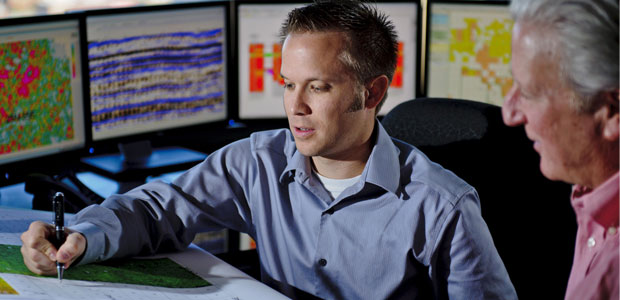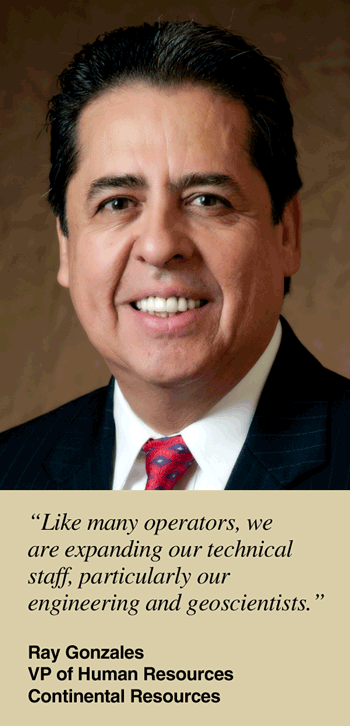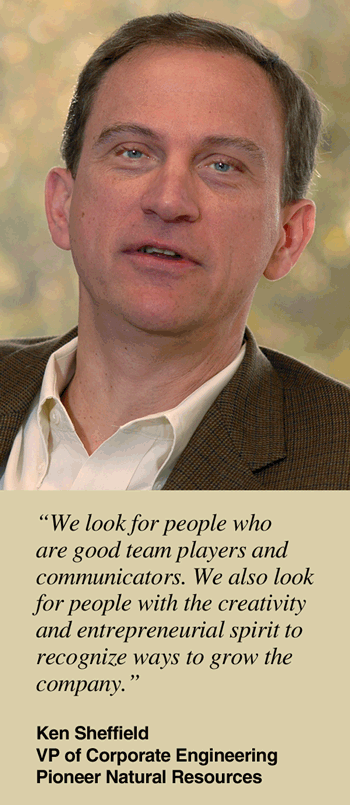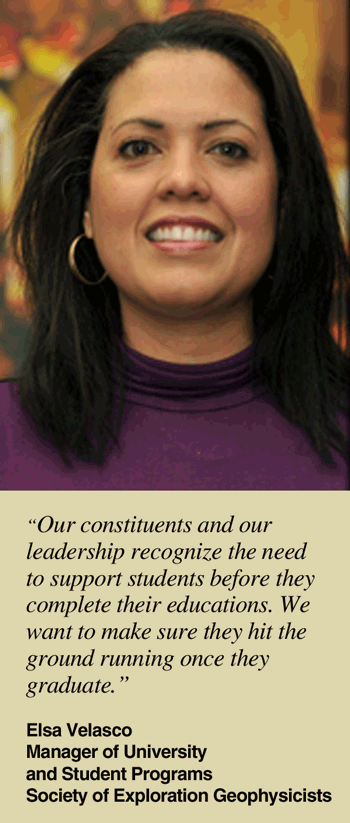
New Graduates Key To Industry Future
By Colter Cookson
Hiring an employee can be similar to searching for a spouse. If a company finds a good fit–someone who shares its corporate values, makes sound decisions, and stays loyal through thick and thin–it will reap great rewards.
With its great pay, rewarding challenges, and impact on almost every aspect of peoples’ lives, the oil and gas industry has attracted its share of good matches. But with producers ramping up activity in response to high oil prices, competition for bright young minds remains fierce. Now more than ever, producers need to put their best foot forward if they want to attract the top talent graduating from geoscience and engineering programs across the United States.
According to Mark Guest, managing director of OilCareers Ltd., which runs the oil and gas job board at OilCareers.com, the demand for engineers is particularly high. “The number of vacancies in the U.S. engineering sector doubled in 2011, with the vacancies for drilling engineers increasing fourfold,” he reports. “This significant growth in demand for engineers will continue into 2012 as projects that were deferred in 2010 come back on stream.”
Guest says interest in engineers extends across the globe. He predicts demand for engineers in mature areas such as the United States will continue to grow as companies become more comfortable employing talent from one area for projects in another. “Many of the engineering projects going on in Houston are for activity that will take place in other parts of the world, such as offshore Brazil,” he says.
But unconventional oil and gas resources are the driving force behind the growing demand for engineers and other professionals. “Because of unconventional plays, there is going to be a lot of work, particularly in areas where the industry has been flat or has not been present in the past,” Guest says, noting that OilCareers.com’s traffic reflects this trend. “Overall traffic is up 27 percent year-on-year, but it is up much more in states with booming shale plays. For example, visits from Ohio are up 55 percent.”
Despite the rising demand for oil and gas professionals, job seekers still need to make a good impression to get the jobs they want, Guest observes. He says they can increase their chances by writing resumes that explain who they are, and not just what they have done. “You need to demonstrate you understand what the industry is about and what it takes to succeed within it. That is difficult to do in a resume, but if you throw in some key phrases such as ‘I am interested in optimizing horizontal drilling operations in oil-rich shales,’ you will have a much better chance than someone who only mentions his degree,” he offers.
At an interview, Guest says job seekers should show they understand where the industry is going and what they want to contribute, especially if they have master’s degrees. “Employers appreciate that; they are looking for the bright young stars of the future,” he says.
Oil Champion
Continental Resources Inc. can claim to have its share of bright young stars. Two of the company’s geologists, 27-year-old Tony Moss and 28-year-old Andy Rihn, appear on Forbes’ “30 Under 30 in Energy” list. In response to rapid growth, the company has recruited 145 new personnel in the past six months, reports Vice President of Human Resources Ray Gonzales.
“Like many operators, we are expanding our technical staff, particularly our engineers and geoscientists.” Gonzales says. “However, we are growing so fast that we have other needs, primarily in land administration, but also in our field operations and corporate functions.”
As an exploration-focused company, Continental is particularly interested in drilling engineers and geologists who specialize in geosteering, Gonzales says. He points out that Continental operates in the Bakken Shale/Three Forks play in North Dakota and Montana; the Red River area in North Dakota, Montana, and South Dakota; the Niobrara Shale in Wyoming and Colorado; and the Anadarko Woodford and Arkoma Woodford in Oklahoma–all of which are drilled horizontally.
Overall, Gonzales says, Continental Resources has had little trouble finding employees and very low turnover. “Some people are more difficult to recruit than others, such as people with experience in division order and lease management, or some of the more specialized engineers,” he acknowledges. “But overall, we get plenty of interest. In fact, we get an average of 80 applicants for each job, with a median around 45. Some jobs reach a couple hundred applicants. If anything slows us, it is making sure we get the right talent.”
For Continental, the right talent means someone with relevant technical skills and a can-do attitude. “We focus on oil, so we look for geologists with backgrounds in oil,” Gonzales elaborates. “Since we have a small staff, we are looking for people who can wear many hats, and who will roll up their sleeves and do the work.”
Gonzales adds that Continental seeks people with the creativity, desire and courage to come up with new ideas and see them through. “We want to keep alive the entrepreneurial spirit this company started with. When someone comes up with a new idea, we try to make a decision about it quickly,” he says.
Continental has used LinkedIn successfully to advertise job positions, Gonzales reports. “We see sites such as LinkedIn, Twitter and Facebook becoming more important as time goes on, so we are looking at putting together a social media strategy and social media training for our existing employees that will help them use these sites to attract young folks to Continental,” he says.
Recruiting Recipe
Whether it is recruiting through social networks or more traditional venues, Gonzales says Continental attracts the right people largely by telling its story. “There are two parts to our story,” he elaborates. “The first is that we have been an oil company for a long time, so we already are in the position many companies want to get to. As a result, we are growing rapidly. That has several benefits for our employees. For example, it means an engineer could rise up the management ranks or stay an engineer, but have the opportunity to explore new areas and try new concepts and ideas.”
The second part of Continental’s story is how it uses its employees, Gonzales continues. “We are a lean company, so people get a chance to broaden out and always have a challenge to tackle,” he reports.
Gonzales adds that Continental encourages its young professionals to take active roles in the company. “Our asset teams do not have official leaders, so younger employees participate on equal terms in the sense that they might lead the discussion during any given week. They also participate in our weekly exploration meetings with our founder, Harold Hamm, and other senior executives, so they get to contribute in situations where our more experienced employees can provide guidance and point out potential pitfalls. We think that helps them grow.”
Gonzales describes developing young talent as an integral component of Continental’s long-term strategy. “With the downturn in the economy and people’s personal portfolios taking a hit, many of the industry’s more experienced employees are staying around longer and continuing to work. However, those who retire in the next five to 10 years still will create a shortage of experienced people. The best way to prepare for that is to develop younger staff today,” he explains.
To that end, Gonzales says, Continental encourages its employees to pursue training opportunities and participate in professional organizations. “Keeping up with the latest developments and interacting with other professionals helps our employees come up with ideas, apply new technologies and best practices, and follow industry activity,” he says.
When young professionals apply to Continental or other producers, Gonzales suggests they tailor their resumes and interview comments to the job. “The more an applicant shows he has experience in the areas relevant to the job, the higher his chances,” he says.
He adds that applicants need to point out what they have delivered, not just what they have done. “Instead of saying you have five years of experience, talk about the projects you participated in over those five years and how you made a difference for your company,” he illustrates. “You should also highlight examples of where you went beyond the bare minimum and tried new ideas and concepts.”
Employee Developer
Pioneer Natural Resources Co., an operator with assets in Texas, Colorado, Kansas and Alaska, has been recognized for the past two years by the Dallas Morning News as number three on the newspaper’s list of the 100 best places to work in the Dallas-Fort Worth area. For the past three years, the company also has been named one of the best companies to work for in Texas in a list sponsored by Texas Monthly magazine, the Texas Association of Business, and the Texas State Council, an affiliate of the Society for Human Resource Management.
According to Ken Sheffield, Pioneer’s vice president of corporate engineering, the company is actively recruiting petroleum, mechanical and chemical engineers.
“We are looking to hire 50-60 engineers in 2012,” Sheffield reports. “About 10 of those will be recent college graduates, and the rest will be experienced engineers.”
Sheffield says the company decides how many graduates to hire based in part on its staff’s ability to train them. “When we bring in new grads, we want to make sure we can provide them with the proper training and mentoring,” he relates.
Pioneer’s training starts with a multiyear program designed to expose engineers to different disciplines. “We have each engineer spend time with our drilling and completions group, our reservoir engineering group, our production operations group, and our facility and project group, so they can see from soup to nuts what all the engineering functions do,” he says. “After the engineers have been through this process, they will know where they want to start their careers. We look at our needs to match them with the right jobs.”
In addition to helping young engineers decide where to focus, the rotation improves their communication skills and shows them how their work fits within the big picture, Sheffield reports. “During the rotation, we try to match them with more experienced engineers so they have people they can reach out to for advice,” he says.
Training Building Blocks
Whether engineers come with years of experience or join the company immediately after graduating, Sheffield says Pioneer does what it can to promote their development. “We encourage our engineers to look at what they want to do with their careers and to develop plans to make sure they have all the building blocks they need to meet their objectives. If people plan their training rather than trying to do it in their free time, they are much more likely to complete it,” he says.
Sheffield adds that Pioneer makes it easy for employees to take advantage of training opportunities. “Our corporate engineering group has a manager of training and development who posts training opportunities on our internal portal and holds regular meetings to make sure engineers know what is available,” he relates. “That way, our employees can easily find and register for training opportunities.”
Of course, before it trains employees, Pioneer needs to hire them. “Like most producers, we look for people with strong technical skills who are good team players and communicators,” he says. “We also look for people with the creativity and entrepreneurial spirit to recognize ways to grow the company and push it forward on their own.”
To identify graduates with those qualities, Pioneer considers applicants’ extracurricular activities and work history. “We want people who have been active and successful, not only in their academic careers, but also in their communities,” Sheffield says. “These people have demonstrated that they are team players and self-starters.”
Pioneer also finds employees through an internship program, Sheffield notes. “Our goal each year is to bring in 30-35 interns,” he says. “That number is small enough that we can comfortably find good mentors for each intern and give him a challenging project where he can evaluate a problem and put together a plan to solve it in only three months.”
At the end of three months, the interns present their solutions and explain how they developed them to a group of engineering managers. “We think the program is a great experience for interns,” Sheffield comments. “It lets them get real-world experience solving problems and working with other people. At the same time, it gives us a chance to see whether they have the ability to work in teams and entrepreneurial spirits, while allowing them to decide whether our culture is a good fit for what they want to do with their careers.”
Preparing Students
To ensure geophysics students graduate with the technical and social skills necessary for work, the Society of Exploration Geophysicists has been expanding its student affairs department. “Our constituents and our leadership recognize that there is a need to support students before they complete their educations,” states Elsa Velasco, SEG’s manager of university and student programs. “We want to make sure they have the resources and skills to have successful academic careers, and the knowledge to hit the ground running once they graduate.”
To accomplish that, SEG provides student members with access to its continuing education programs and lecture series; subscriptions to The Leading Edge trade journal, the Geophysics peer-reviewed journal, and the Anomaly student newsletter; as well as technical books through the Fred and Kathi Hilterman SEG Foundation Student Chapter Book Program. Velasco adds that in partnership with the American Association of Petroleum Geologists and the European Association of Geologists and Engineers, SEG hosts expositions that give students a chance to show their expertise to several companies at once.
Velasco points out that the association also runs:
- The SEG/Chevron Student Leadership Symposium, which builds the leadership and problem-solving skills of student chapter officers;
- The SEG/ExxonMobil Student Education Program, a two-and-a-half day course on multidisciplinary subsurface integration for exploration and production;
- The Challenge Bowl, a competition that tests students’ understanding of the geosciences; and
- Geoscientists Without Borders®, an SEG Foundation grant program through which professionals, professors and students use geosciences in humanitarian projects across the globe.
Velasco points to the SEG/ExxonMobil Student Education Program to illustrate the overall goal of the student affairs department. “By the end of the program, the students have gone through a high-level technical boot camp and have worked with a team of people they do not know to deliver a result,” she says. “They come out with a much better understanding of what it takes to be a geophysicist.”
In addition to technical skills, SEG helps students learn the social graces needed to excel. “Students worry about nontechnical skills that can make a difference in their careers, such as how to interact with their bosses, network and manage their time, and keep a sustainable balance between work and personal life,” Velasco observes. “Through workshops, articles, blogs, e-mails and phone calls, we try to explain what they need to know. During our annual meeting, we also provide opportunities for them to practice those skills so they can gain experience in a safe environment.”
Velasco stresses that none of SEG’s student programs would be possible without members’ support. “Our programs only work because we receive funding from companies with many demands on their capital and time from people with jobs who often require long days,” she says. “Since I got involved in SEG, I have been impressed by how hard these people work and how much they want students to succeed.”
If Velasco could give students only one piece of advice, she says it would be to develop a support system. “You need a support system in your personal life that can keep you grounded; coworkers who can tell you what is going on, what you should do, and with whom you need to talk; and mentors in your field, but outside your company, who can give you the high-sky view of how things should go and point out details you might be missing,” she says. “If you have these support systems, you can grow into a capable professional with minimal stress.”
Professional Development
According to Tom Agnew, SEG’s director of professional development, the association’s continuing education programs help members hone their technical skills by providing courses and lectures on relevant topics and emerging trends. Toward that end, he says the association has added courses on microseismic-based reservoir monitoring, full waveform inversion, time frequency analysis, and geopressure’s role in evaluating prospects, as well as a class on writing in the earth sciences.
In addition to offering advanced courses for experienced professionals, Agnew says SEG provides introductory courses for the emerging workforce. For example, through its partnership with International Human Resource Development Corp., the association offers online courses on seismic pulse generation, transmission and reflection; array design; and seismic processing and interpretation.
Although in-person courses and lectures will continue to be the backbone of SEG’s professional development program, Agnew says the association is expanding its online offerings. “We are looking at everything we do to see what would be appropriate to develop into a full-length virtual course or webinar,” he reports. “We also are having our lecturers narrate their presentations after their tours so we can make their information available to all our members anywhere in the world.”
Many of SEG’s online courses are self-paced topical overviews that include tests so students can verify they understand the material, Agnew says. Although most are two to three hours long, SEG is developing lengthier courses divided into two, three-hour lessons. “These courses will include a pre-assessment people can take before they buy the lessons to determine whether they should start with the first lesson or jump to the middle,” Agnew details.
The first course–planned for rollout this spring–will be on seismic waves, and will include 10 lessons, Agnew says. “We are very excited about it,” he says.
SEG also offers live online webinars on hot topics such as gravity and magnetics, and subsurface seismic. “We try to keep these courses around 90 minutes long,” Agnew says. “They are meant to give attendees the basic information they need immediately, and to help them decide whether they want to dig deeper into the topic.”
Agnew says the online courses have gotten a tremendous response. “Our virtual classes average more than 100 students a session, including some who are calling in at 4 a.m. from Asia or Australia,” he reports. “We are doing a class every other month, but we are planning to see whether there is interest in doing them at least once a month.”
Participants can submit feedback during or after the class, Agnew notes. “We greatly value the feedback we receive,” he says. “It helps us make sure the information we provide is useful and to work with the instructor to address any problems.”
Geology’s Promise
According to Larry Nation, AAPG director of communications, the demand for entry-level geologists remains strong. “The number of geologists changing jobs has slowed from previous years, which is a sign companies want to hang on to the geologists they have,” he says. “Consequently, salaries have gone up for the past several years.”
Nation indicates that AAPG was expecting to see a moderate increase in salaries across all experience levels in its 2012 salary survey, which was scheduled to be released in April. He adds that companies have been hiring more consultants through the AAPG Career Center, the association’s online job board.
“We are extremely cognizant of our duty to provide opportunities for members to get jobs and develop their skills as professional petroleum geologists,” Nation comments. “Career advancement and enrichment is one of our most important goals.”
As part of that, Nation says AAPG offers a variety of services to its members, including on- and off-line continuing education courses, educational conferences, field seminars for both students and professionals, and a distinguished lecturer program. Members also receive access to The Explorer, AAPG’s monthly newspaper for geologists, geophysicists and reservoir engineers, and the AAPG Bulletin, a peer-reviewed geoscience journal.
“We have career centers on site at all our conventions, with computers, so people can create and improve their resumes and companies can post jobs and conduct interviews,” Nation reports. “These centers provide a multitude of opportunities for both seasoned geologists and students to mix with employers and get hired.”
Nation adds that the association hosts regional student expos where potential employers and students gather and students present poster sessions to showcase their skills. “These expos provide a great opportunity for recruiters to meet students from the universities they do not cover, including ones with limited ties to the oil and gas industry,” Nation suggests. “Given the benefits of an oil and gas career and companies’ need for manpower, we think they are a great opportunity for both students and employers.”
Nation encourages students to get involved with professional organizations, read oil and gas publications, and present technical papers. “Potential employers always are looking for scientifically competent individuals seeking careers and not just a job. Being active in professional organizations and following industry events demonstrates those qualities,” he explains.
He also advises students to network through traditional venues and social media, saying, “The wider your personal network, the more opportunities you will hear about and the more opportunities you will have.”
Long-Term Planning
As the petroleum engineers and geoscientists who entered the workforce before the mid-1980s approach retirement, the industry will need to pass leadership responsibilities to their younger peers. Because oil and gas companies limited their recruiting from the mid-1980s to the late 1990s in response to low commodity prices, many roles will go to people with limited experience, observes J. Ford Brett, the managing director of training provider PetroSkills. He chairs the Society of Petroleum Engineer’s Talent Council, which formed in 2007 to help the industry manage the “great crew change” and meet other human resource challenges.
Many companies are doing what they can to prepare their midlevel employees for more demanding responsibilities, Ford says. He adds that when oil prices fell during the recession of 2008-09, many companies maintained strong recruiting and training programs. “They recognized that the companies that kept their geologists and engineers during downtimes would be the first to benefit when prices went back up,” he says.
To prevent another great crew change, Brett encourages companies to adopt long-term approaches to human resources and to work on improving the industry’s image. “There are enough technical people graduating from universities around the world to meet the industry’s needs, but we must to make sure they enter the petroleum business or related fields such as mechanical engineering,” he says. “Because it takes a long time to turn someone into a geologist or an engineer, we need to get their interest before they enter college.”
Brett admits that will be a difficult task. “The oil and gas industry is like the Central Intelligence Agency: people only hear about us when we make a mistake, so they often view us in a negative light,” he assesses. “They forget that because we are here, they can turn on their lights, take warm showers, and travel across the country on family vacations. As an industry, we need to do a better job of controlling the microphone and telling our story.”
To attract employees, Brett says oil and gas companies need to highlight their safety and environmental records. “The most dangerous thing about working offshore is driving to the helideck,” he quips. “Working offshore used to be more dangerous, but since 1975, lost-time accidents have gone down 95 percent. That is not a coincidence. It happened because we took safety seriously and wanted to improve it.
“We need to highlight how much computers, other technology and innovation drive our business to counter the perception that it is old-fashioned,” he adds.
To help the industry improve its image, SPE has developed kits that high school teachers may use to introduce students to the science behind oil and gas development. “These efforts are finding traction with some teachers, particularly in places where the oil and gas industry has a strong presence, such as Texas, Oklahoma and Wyoming,” Brett reports.
Ongoing Training
Once people embark on oil and gas careers, Brett says the industry needs to train them. “While it is possible to learn on the job, it tends to be expensive and slow because everyone has to learn the hard way, which means they make mistakes that could have been prevented,” he says.
To help students and recent graduates get up to speed quickly, SPE has developed an online mentoring program, Brett reports. He says it connects people with fewer than five years of experience to oil and gas veterans who can provide guidance on career paths and day-to-day issues.
Brett adds that the Talent Council conducts research to help oil and gas companies attract and retain talent. As an example, he cites a survey of SEG members that found dual-career couples constituted half the total workforce. Because these couples tend to be young, the survey predicts the percentage will go up with time, which means employers that accommodate those couples will have an advantage in attracting and retaining top talent.
The survey suggests companies provide advancement opportunities that do not require employees to relocate, adopt flexible policies for dual-career parents, and treat spouses who both work for the company as individuals when making decisions about their compensation and advancement opportunities.
Expanding The Talent Base
Like Brett, Mark Guest of OilCareers.com says he sees public outreach as vital to oil and gas companies’ long-term success. “We need to make sure teenagers realize that the sneakers on their feet and the plastic in their steering wheels are made from oil and gas,” he says. “If we fail to do that, we may face another great crew change because far too many youths will see oil and gas as a dying industry, not one full of rewarding careers.”
For now, Guest suggests companies that cannot find employees with the necessary experience consider recruiting people with transferable skills from other industries. “Many veterans have engineering training, and they understand the importance of discipline, health and safety, more than anybody,” he says. “People who know how to use heavy machinery and drive heavy trucks, such as forestry and farm workers, also can be assets if they are aware of the opportunities in the oil and gas sector.”
Whether companies are trying to hire engineers or truckers, Guest advises them to look at the terms for comparable positions before advertising their jobs. “Employers need to make sure their salaries are competitive with others in their areas, and state their terms and conditions clearly and accurately,” he says.
Although competitive salaries and benefits help companies attract employees, Guest stresses that people want more. “People are looking for quality employers, so it is very important that employers get a compelling message across. They need to explain why they are better than other employers.”
Guest indicates that most job seekers are looking for companies that can provide career, and not merely jobs. “They want employers that can demonstrate innovation and leadership, as well as good health, safety, and environmental standards,” he adds.
For other great articles about exploration, drilling, completions and production, subscribe to The American Oil & Gas Reporter and bookmark www.aogr.com.

















